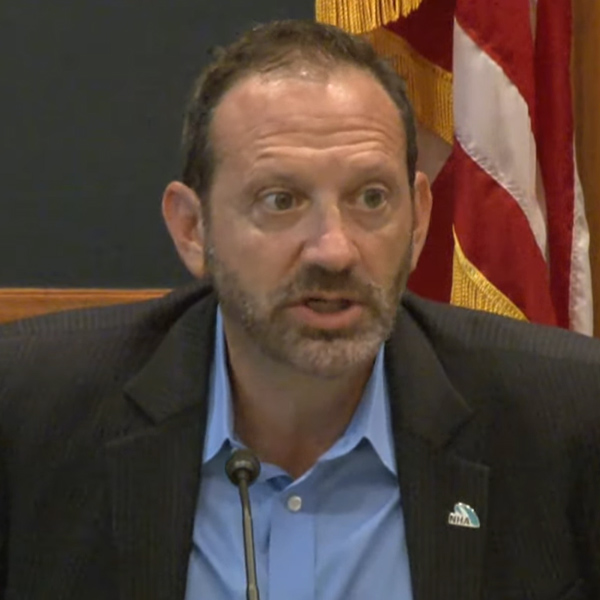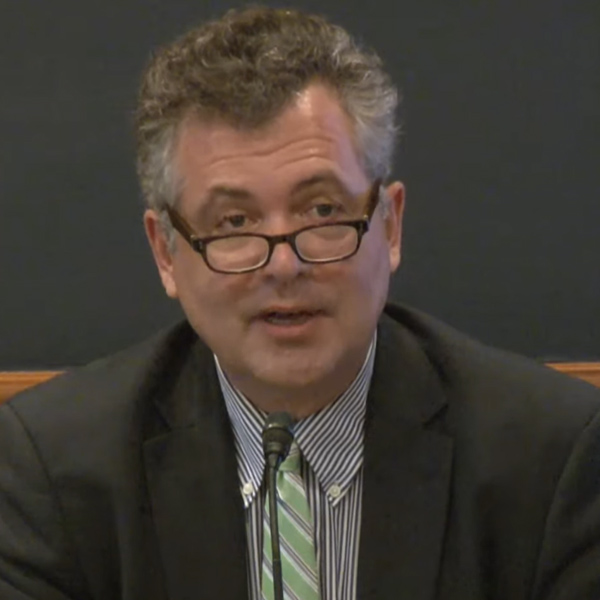The Infrastructure Investment and Jobs Act (IIJA) provides $753 million to help hydropower dams improve their efficiency, safety and resilience, as well as providing production incentives for existing dams to add hydropower to their operation, according to a fact sheet from the National Hydropower Association (NHA).
But what it doesn’t do, said NHA CEO Malcolm Woolf, is address a more pressing issue in the industry: reform of the multiyear, massively expensive federal relicensing process that is driving some dams to stop producing power and give up their licenses.
 Malcolm Woolf, NHA | EESI
Malcolm Woolf, NHA | EESI“The number of voluntary license-surrenders has been increasing,” Woolf told a live and virtual audience at the Environmental and Energy Studies Institute (EESI) Congressional Renewable Energy and Energy Efficiency Policy Forum on Capitol Hill on Monday. “We had 41 facilities give [licenses] up in the 2010s. We’ve had another 17 in just the last two years … which becomes really dangerous when you realize that half the nonfederal fleet is up for relicensing by 2035.”
Woolf was one of eight energy industry officials speaking at the live event, which focused on the opportunities created by the IIJA, the challenges of the law’s implementation and the policy gaps that still need congressional action, including hydropower relicensing.
For Curt Rich, CEO of the North American Insulation Manufacturers Association, the law’s $225 million to help update and implement more energy-efficient building codes represents “an unheard-of level of investment.”
“The Department of Energy building code program kind of walks along at about $5 [million] to $10 million a year,” Rich said. With the increased funding, and “as you train the workforce to enforce updated codes and implement updated codes, it in turn is really going to catalyze energy-efficient construction and just support all of the other initiatives that are underway across building sectors to drive energy efficiency.”
Rich also sees IIJA money going to states for energy-efficiency incentives as a key driver for the industry, especially to motivate commercial or multifamily building owners to move ahead with upgrades.
“It’s really hard to get people to just act in their own interest,” he said. “The money for efficiency programs that will be flowing through residential, commercial and industrial buildings, principally through the states, that will provide decent incentives for building owners to act.”
 Bill Parsons, ACP | EESI
Bill Parsons, ACP | EESIBill Parsons, vice president for federal and state affairs at the American Clean Power Association, spoke about the IIJA provisions giving FERC backstop siting authority to override state opposition to interstate transmission projects as a vital step forward.
Increasing renewables on the grid will make a major buildout of the transmission grid essential, Parsons said, but he also argued that intermittent renewables should not be automatically viewed as “unreliable.”
Nationally, renewables “were about 14% of the generation mix last year,” he said. But “at times, in certain areas, we have been 80%. You didn’t hear about it because there was no reliability issue.”
Parsons also raised concerns about the IIJA’s Made in America preference on projects receiving federal dollars: for example, funds for building out the electric vehicle and lithium supply chains. While a domestic energy storage supply chain is “critically important,” he said, it is “unrealistic” to require a 100% U.S. supply chain on projects receiving IIJA funds.
“We don’t hold many other industries to a standard of 100% sourcing domestically,” he said.
Pitching to the audience of congressional staffers at the event, Parsons additionally pointed to a crew-mandate bill passed in the House of Representatives earlier this month as part of the defense authorization bill, which would require crews on U.S. ships working on offshore wind or oil projects to be American citizens or permanent residents, or from the same country as the vessel’s flag.
“It’s literally going to freeze the first 19 offshore wind projects in [their] tracks,” he said. “We need to train people to crew [these ships], but we need to be realistic about time frames as it relates to mandates and how these vessels are crewed if we don’t want to freeze the offshore wind industry before it has a chance to begin.”
The Digital Energy Workforce
The IIJA provided $62 billion to the Department of Energy, which Kelly Speakes-Backman, principal deputy assistant secretary for the department’s Office of Energy Efficiency and Renewable Energy, said is “the biggest investment to the department since our founding. It stands up 60 entirely new programs, and it expands 12 existing ones.”
In the nine months since President Biden signed the bill into law, $13 billion in funding has been made available, and about half of the 60 new programs have issued requests for information, drawing thousands of pages of industry and public input, she said.
“That’s one thing you’ll see about the way we do our business these days: really making sure that it is locally placed information to draw from to build out our program,” Speakes-Backman said.
Joy Ditto, CEO of the American Public Power Association, also talked about the importance of community engagement in making sure the IIJA is implemented to benefit smaller communities. While the law’s many programs and funding announcements are a huge opportunity for the nation’s 2,000 publicly owned utilities, Ditto said, many of her members, especially smaller utilities, have challenges just applying for the money, either because of limited staff and expertise, or they are not sure if they will qualify for specific programs.
“A lot of our focus now is just enabling our members to interface with the federal government, giving them resources to access funds as they become available,” Ditto said.
The close connection between workforce development and ensuring the success of IIJA projects was another key theme at the forum. As of 2021, the U.S. energy workforce stood around 7.8 million, with 40% of that total employed in “net-zero-emissions-aligned” jobs, according to DOE’s recently released U.S. Energy and Employment Report.
But Jeannie Salo, North America vice president for government relations at Schneider Electric, was adamant that those workers and others coming into the energy sector need to be trained with digital jobs skills.
“We often talk about the digital economy,” Salo said. “There is no other economy; it’s just the digital economy, and digitization is at the core of everything we need to do to be more efficient, to transform our infrastructure.”
“The barriers are training that’s tied to real jobs and [the] lack of awareness of clean energy careers at all in secondary schools,” she said. Schneider is upskilling its workers at a “smart factory” in Kentucky, she said, which is helping the company attract and retain workers.
Jason Walsh — executive director of the BlueGreen Alliance, a coalition of labor unions and environmental groups — agreed, saying a well trained and credentialed workforce “is going to matter more than ever.”
“The climate crisis is so urgent, we’ve only got one shot to do this right,” Walsh said. “And so verifiable, credentialed skills for the workers that do that work are going to be absolutely fundamental because they’re not going to get another go.”
At the same time, Walsh said the clean energy transition will require investment and workforce development levels well beyond the IIJA.
“The clean energy, energy-efficiency economy is inherently more labor intensive than an economy based on fossil fuels and waste,” Walsh said. “Manufacturing and installing sources of our fuel rather than burning them — that creates jobs. In the building sector, energy efficiency turns the wasted energy into work, so that goes from no jobs to lots of jobs.”




